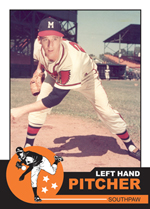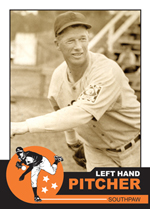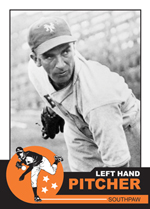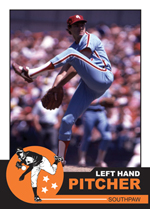Sandy Koufax
(1955-1966)
The Man with the Golden Arm
His career wins (165) are hardly worthy of Hall of Fame status, but
from 1961 to 1966, Sandy Koufax showed a brilliance that baseball has
rarely seen. He won three Cy Young Awards, each by unanimous votes.
He was the first to win the award more than once, and he won them in
the day when there was only one Cy Young Award given to all of baseball. He
is one of the very few pitchers in history with more career strikeouts
than innings pitched. Three times he won the pitching Triple Crown – most
wins, strikeouts and lowest earned run average in a season. He
holds the record for most shutouts in a season (11) by a lefty (set 47
years earlier by someone named Babe Ruth) and held the record for most
no-hitters (4) as well as the season strikeout record until Nolan Ryan
broke both marks. He still holds the season record of 323 innings
pitched while not hitting a single batter – a tribute to his precise
control.
|
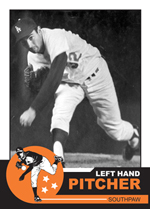
“I knew every pitch he was going to throw and
still I couldn’t
hit him.” - Willie Mays |
Born in Brooklyn, New York,
Koufax was a natural athlete. He excelled at basketball, earning
a scholarship to the University of Cincinnati and, later, several offers
from NBA teams. But he loved baseball. In a tryout for the Brooklyn
Dodgers, scout Al Campanis stood in the batter’s box while Koufax
pitched. Campanis later said, “The hair on my arms rose,
and the only other time that happened was the first time I saw the Sistine
Chapel.” The Dodgers signed him immediately, and Koufax embarked
on a career that included four World Series, where his career earned
run average was a mere 0.95. His main pitches were a blazing fastball
that actually jumped up at the plate and a devastating curveball.
Of note was the 1965 World Series when Koufax, of the
Jewish faith, declined to pitch the first game while observing Yom Kippur. He
went on to pitch games two, five, and seven (the last two were complete-game
shutouts) and earn the World Series MVP award.
Prior to the 1966 season, doctors told Koufax he needed
to retire because of the arthritis in his pitching arm, a source of intense
pain for the southpaw. Koufax instead pitched brilliantly in the
1966 season, going 323 innings with a 27-9 record and an impressive 1.74
ERA. He retired shortly after the World Series and, five years
later, became the youngest person ever elected into the Baseball Hall
of Fame.
Post note: Forty-one years after he retired, Koufax
was the final player chosen in the inaugural Israel Baseball League: “His
selection is a tribute to the esteem with which he is held by everyone
in this league.” |
